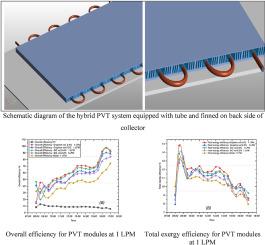使用带有平背形翅片、管道、纳米流体和相变材料的模块化集热器的光伏热(PVT)系统的实验评估
IF 6.3
2区 材料科学
Q2 ENERGY & FUELS
引用次数: 0
摘要
近年来,研究如何降低光伏(PV)单元电池因太阳能过剩而导致的温度升高,并将其转化为热能而非电能,从而导致电压输出降低,进而降低整体效率,已成为众多研究的趋势性课题。本研究提出了一种新型集热器,它是由一系列扁平散热器和蛇形铜管组成的组件,装在一个充满石蜡的密闭容器中。该组件作为一个单独的组件,用螺钉夹紧并固定在光伏板的后侧。通过使用 SiC/水和石墨烯/水纳米流体和水作为冷却介质(体积分数分别为 0.2% 和 0.4%,流速分别为 0.5LPM 和 1LPM),对所提议的系统进行了室外实验研究,并将该系统与无冷却的光伏面板进行了比较。实验结果表明,与使用水作为冷却剂和无冷却系统相比,两种纳米流体都会导致温度下降。同时,实验结果表明,石墨烯纳米流体的降温幅度更大,因此功率和效率更高。此外,增加工作流体的体积浓度和流速可在所有测试中获得更好的性能。此外,纳米流体的体积浓度和流速增加会导致温度降低更多,从而提高电效率和热效率。本文章由计算机程序翻译,如有差异,请以英文原文为准。

Experimental evaluation of photovoltaic thermal (PVT) system using a modular heat collector with flat back shape fins, pipe, nanofluids and phase change material
In recent years, the study of decreasing photovoltaic (PV) units cell temperature increase caused by solar excess energy, which is converted into heat rather than electrical energy, resulting in voltage output reduction and thereby lowering overall efficiency, has been the trending subject of much researches. In this study, a novel heat collector, which is an assembly of a series of flat heat sinks and serpentine copper tubes in an enclosed sealed container filled with paraffin wax is proposed. This assembly as an individual set is clamped and attached by screws to the rear side of the photovoltaic panel. The proposed system was experimentally investigated outdoors by utilizing SiC/water and Graphene/water nanofluids and water as cooling mediums with volume fractions 0.2 % and 0.4 % at 0.5LPM and 1LPM flow rates and this system was compared with a photovoltaic panel with no cooling. The achieved results showed that both nanofluids caused temperature drop compared to using water as coolant and the system with no cooling. Also, experimental results showed that the Graphene nanofluid caused more temperature reduction and accordingly resulted in higher power and efficiencies. Moreover, increasing volume concentration and flow rate of the working fluid led to have better performance in all the tests. Also, increasing volume concentration of nanofluid and flow rate caused to have more temperature reduction and as a result, more enhancement in electrical and thermal efficiencies.
Kewwords
Photovoltaic thermal (PVT); Heat collector; Flat back shape fins, Fins, Nanofluids; Phase Change Material (PCM).
求助全文
通过发布文献求助,成功后即可免费获取论文全文。
去求助
来源期刊

Solar Energy Materials and Solar Cells
工程技术-材料科学:综合
CiteScore
12.60
自引率
11.60%
发文量
513
审稿时长
47 days
期刊介绍:
Solar Energy Materials & Solar Cells is intended as a vehicle for the dissemination of research results on materials science and technology related to photovoltaic, photothermal and photoelectrochemical solar energy conversion. Materials science is taken in the broadest possible sense and encompasses physics, chemistry, optics, materials fabrication and analysis for all types of materials.
 求助内容:
求助内容: 应助结果提醒方式:
应助结果提醒方式:


